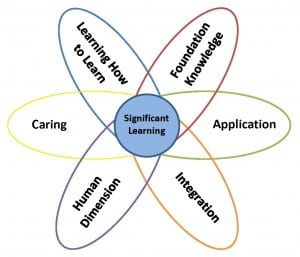Part 2 – How to Create Significant Learning in a Library Setting
Lauren Hays
In my previous blog post, I introduced Fink’s Taxonomy of Significant Learning and shared about the areas of foundational knowledge and caring. In this post, I will share ideas for how to create learning opportunities in the areas of application, integration, human dimension, and learning how to learn.
As a reminder, Fink’s Taxonomy of Significant Learning includes six areas that interact, but are not hierarchical. Additionally, each area of significant learning can stand on its own.
The six areas are:
- Foundational Knowledge: understanding and remembering information and ideas; Foundational knowledge provides the basic understanding that is necessary for other kinds of learning.
- Application: skills, critical thinking, creative thinking, practical thinking, and managing projects; The act of making new connections gives learners a new form of power, especially intellectual power; application learning allows other kinds of learning to become useful.
- Integration: connecting information, ideas, perspectives, people, or realms of life; The act of making new connections gives learners a new form of power, especially intellectual power.
- Human Dimension: learning about oneself and others; This kind of learning informs students about the human significance of what they are learning
- Caring: developing new feelings, interests, and values; When students care about something, they then have the energy they need for learning more about it and making it a part of their lives. Without the energy for learning, nothing significant happens.
- Learning How to Learn: becoming a better student, inquiring about a subject, becoming a self-directed learner; This kind of learning enables students to continue learning in the future and to do so with greater effectiveness. (Fink, 2003, pp. 3-6).
Using Fink’s Taxonomy of Significant Learning in the Library
Application: In library instruction, we often teach about evaluating sources. We help library users think about the context of the source, the date of publication, the author, how to determine if a source fits their information need, etc.. To create opportunities for library users to apply their knowledge about source evaluation, we should build in practice during instruction sessions. Additionally, when working with library users, source evaluation can become part of the reference interview when we include questions such as:
- What will help you answer your question?
- Who are important authors/organizations in this area?
- Is the date of the information relevant to your need?
Integration: In the Framework for Information Literacy in Higher Education from the Association of College and Research Libraries, one of the frames in Scholarship as Conversation. The authors of the Framework defined Scholarship as Conversation as, “Communities of scholars, researchers, or professionals engage in sustained discourse with new insights and discoveries occurring over time as a result of varied perspectives and interpretations.” Personally, I think it is important for librarians to describe to library users scholarly discourse. Explain to users how to conduct citation chaining. Additionally, explain that the more individuals read, the more they will see connections in thoughts and ideas.
Human Dimension: For me, the human dimension may be the most challenging area of Fink’s Taxonomy to use in library instruction. However, I also know that there is an important human element in research. One way I will incorporate the human dimension into instruction is to ask library users to conduct a self-evaluation where they reflect on their level of confidence with information research. This evaluation would only be for the users, but I would encourage them to use it to know when they need to ask for assistance.
Learning How to Learn: This area of significant learning ties closely to adult learning theory which I have discussed in previous posts. Adult library users need to know how to explore resources on their own and why they might want to do that (it helps them become familiar with the literature, serendipitous searching, etc.). It can be helpful for adult library users to be given some tips for how to be a better user of the library so they are confident in becoming a self-directed library user.
Please post in the comments if you have other idea for how to incorporate Fink’s Taxonomy of Significant Learning into library instruction.

References
Armstrong, P. (2010). Bloom’s Taxonomy. Vanderbilt University Center for Teaching. https://cft.vanderbilt.edu/guides-sub-pages/blooms-taxonomy/
Fink, L. D. (2003). What is significant learning? https://www.wcu.edu/WebFiles/PDFs/facultycenter_SignificantLearning.pdf
Fink, L. D. (2013). Creating significant learning experiences: An integrated approach to designing college courses (Rev. Ed.). John Wiley & Sons.
Lauren Hays
Lauren Hays, PhD, is an Assistant Professor of Instructional Technology at the University of Central Missouri, and a frequent presenter on topics related to libraries and librarianship. Her expertise includes information literacy, educational technology, and library and information science education. Please read Lauren’s other posts relevant to special librarians. And take a look at Lucidea’s powerful integrated library systems, SydneyEnterprise, and GeniePlus used daily by innovative special librarians in libraries of all types, sizes and budgets.
Never miss another post. Subscribe today!
Similar Posts
Teaching about AI in the Workplace
Suggestions for special librarians from Claude on how to foster cross-generational AI learning communities in the workplace.
Keeping up with AI…
Resources for staying current on the quickly changing AI landscape from a library expert.
Interview with Lesley Farmer about SLA’s Information Outlook
Interview about the rebirth of SLA’s Information Outlook as a quarterly online publication with interview with Professor Lesley Farmer
Ways I Have Been Using Generative AI
Generative AI can be used in many ways as part of a typical workflow; examples and thoughts about what the future holds




Leave a Comment
Comments are reviewed and must adhere to our comments policy.
0 Comments